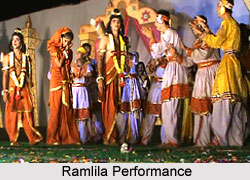 Ramlila of Bhimtal demonstrates the importance and significance of the folk theatre of north India. Ramila at Bhimtal, a village area around the Bhim Lake in the mountainous north of the Indian State of Uttar Pradesh, is a popular destination for the traditional folk theatre of India. Bhimtal is located in the Kumaun division, an administrative unit in which the linguistic situation, which is of particular interest in the present context, is characterized by widespread bilingual characteristics.
Ramlila of Bhimtal demonstrates the importance and significance of the folk theatre of north India. Ramila at Bhimtal, a village area around the Bhim Lake in the mountainous north of the Indian State of Uttar Pradesh, is a popular destination for the traditional folk theatre of India. Bhimtal is located in the Kumaun division, an administrative unit in which the linguistic situation, which is of particular interest in the present context, is characterized by widespread bilingual characteristics.
Ramlila at Bhimtal, and festivals organized at many other places as a joint community effort, owes most of its tremendous popularity throughout Northern India. Apart from the northern part of India the popularity reaches far beyond and is often exclusive, textual base like the Ramcharitmanas written by Tulsidas - an epic begun in the year 1574 and composed in Old Avadhi, the language once spoken around Ayodhya, the legendary birthplace of Lord Rama, in the former province of Awadh.
The Bhimtal Ramlila is a representative of the dramatized and sung variety, a theatrical form which is bound to remind the Western listener of European Nummernoper (such as The Magic Flute), with its rather indifferent prose dialogues meant to urge along the plot and making one feel the impatience of all the participants to hear it blossom out into the next aria. However, at fairly regular intervals the Bhimtal presentation of the Ramlila is articulated by a so-called Jhanki (tableau vivant) accompanied by community singing, obviously a traditional element, which, along with the occasional imposition of a Jaykar (cheer) for one of the heroes, serves the subsidiary purpose of disciplining the audience back to attention. Another traditional element is the Julus (procession), which around the Bhim Lake, quite naturally becomes an aqueous affair: a fleet of rowing boats is led from the upper to the lower end of the lake by the boat occupied by Lord Rama and his company, who on arriving at their destination, join in a perfect staging of their meeting with Bharata, one of the brothers of Lord Rama. In this manner, the natural environment helps to build up one of the climaxes of the play.
Watching the Ramlila is open to all; acting in it is reserved to members of the Brahman (priest) and Thakur (warrior) castes; being chosen for a swarup, i.e. an impersonation of Lord Rama and his three brothers or, of course, his wife Sita, is the prerogative of Brahman boys as yet unaffected by puberty, who are then considered more than mere actors on the stage: during the eleven days` performance, and most probably quite some time before and after it, they are supposed to live their parts twenty-four hours a day. Females, as a rule, are not allowed on the stage; however, in the 1979 production, quite sensationally, a solitary girl played the part of Sita`s sakhi (girl companion).




